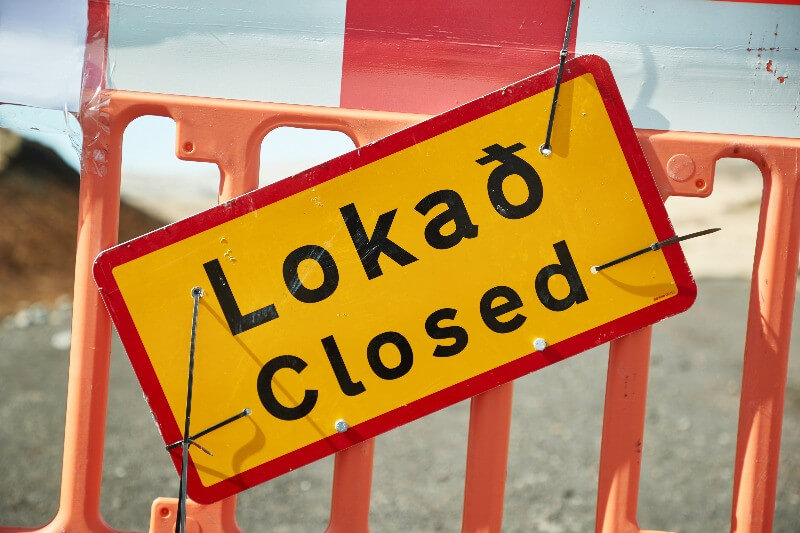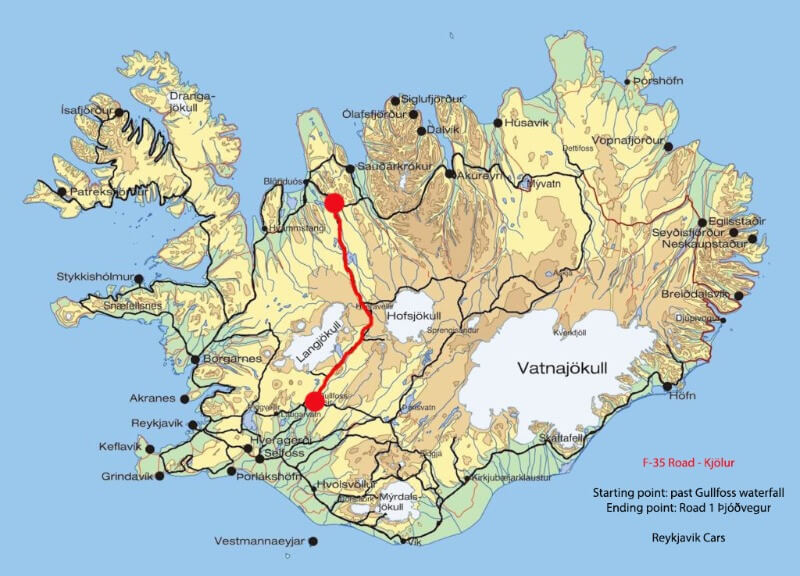The best way to explore Iceland is by taking charge and driving your own car. This way, you can get around to most places without much hassle, and you don’t have to keep anyone’s timetable but your own. A regular car will take you far, but for the real adventure, you must be equipped to take on the F-roads in Iceland.
These are the roads that will take you to the heart of the nation and give you a taste of the strong and durable Icelandic spirit. The F-roads in Iceland are the paths of adventure, and in this article, we tell you all there is to know about them.
What Are the F-Roads in Iceland?
When you’re reading up on what to do in Iceland, driving the Ring Road will pop up more than once. It’s the perfect scenic route to take around the island that doesn’t take much effort or provides many challenges, so where do you go if you want some excitement? Well, the F-roads in Iceland, of course!
The F-roads in Iceland are for those who want to get off the beaten path and explore the wild part of the country. It’s so wild, in fact, that you will sometimes wonder if you’re driving on a road at all! Here, there are no permanent settlements, and nature will continuously take your breath away. It’s a good thing you’ll be in some of the cleanest air in the world, so just take a lot of deep breaths.
As you drive the F-roads in Iceland, you’ll be driving on everything from neatly maintained gravel roads with plenty of space to some barely visible tire tracks left by the previous visitor. Most roads are in good condition, but others might be in a really bad state. One of the reasons for this is that all roads are very remote and hard to reach, making it hard to maintain. The other reason is that these are supposed to be roads in the wild, and if they’re not broken, there’s no reason to “fix” them.

Why Are They Called the F-Roads?
As you might already have guessed, the F-roads in Iceland are called F-roads because they are in the mountains and highlands. “Mountain” in Icelandic is “fjall”, so these are “fjall-roads” and are characterized by an “F” in front of their road number.
These roads came about in 1894 when the Icelandic government started classifying roads to determine who would be responsible for what. The road network was divided into 4 categories:
- National roads: paid for by the government, and suitable for carriage transport.
- Provincial roads: paid 50/50 by the province and government when they could be used by carriages and 100% by the provinces when they couldn’t.
- Parish roads: paid for by the local parishes/municipalities and almost only important for those communities.
- High roads, or as we like to call them, “F-roads”: bridlepaths through the highlands and mountain regions with the only waymarks being stone cairns erected by the government.
This classification came before the first car had arrived in Iceland. So, the “F-roads” at the time were roads for horseback riding and hiking. It wasn’t until many decades later that they were repurposed to also be suitable for cars.

Which Car Should You Rent for the F-Roads?
Regardless of how skilled and adventurous you are, there is only one answer to this question: a 4x4 vehicle. The Iceland F-Roads are rough, and you can’t drive them with the average car without risking yourself and others. When you choose your ride, be sure to pick one with good clearance between the undercarriage and the ground so you don’t get stuck on a rock or small dirt mound.
Since Iceland is the Land of Fire and Ice, you won’t struggle to find a 4x4 in any of the car rental companies around the country. In fact, at Reykjavik Cars we got plenty of 4x4 and SUVs for you to choose from!
What you need to keep in mind, though, is that even though the country has a well-built electric vehicle charging network, it doesn’t extend to the F-roads in Iceland. Ensure you pick a petrol- or diesel-powered car so you don’t get stranded in an area without electricity.

When Do the F-Roads Open and Close?
So, the thing about F-roads in Iceland is that they’re not always open to the public. Back when you would go on horseback or on foot, it made sense to not go into the Icelandic Highlands in the winter. In modern times, the danger isn’t as tangible since cars will protect us from the weather, and we can move around much faster.
Unfortunately, this has made most people a little overconfident in their ability to maneuver the terrain, even in the worst of weather. Driving the F-roads in the wrong season will result in an accident at some point, so the government made the call to only have the F-roads open for parts of the Icelandic Summer.
In addition to this, the roads are also closed because of the conservation of the flora in the highlands. Since the F-roads in Iceland are mostly used by hikers and people who want to be in nature, their accessibility is directly linked to the wear and tear of the highlands. More people = more effect on nature. To counter this, the F-roads will only open when the flora in the mountains is established for the season and can better handle the wear from visitors.
The F-roads will typically be open from the middle of the summer to the beginning of fall. The different roads will open and close at different times since they have their own unique prerequisites.

Estimated Opening of the F-roads in Iceland?
The downside of opening and closing the roads depending on the weather and when the plants are ready is that it will happen at different times each year. The best way to get some sort of idea of when the roads will open and close is to check the times from previous years.
Below is a table of when some of the main F-roads opened between 2018 and 2022:
|
Road |
Earliest opening |
Latest opening |
Median opening |
|
F206 |
12th June |
1st July |
21st June |
|
F208 |
5th June |
8th July |
22nd June |
|
F210 |
21st June |
15th July |
3rd July |
|
F225 |
28th May |
24th June |
16th June |
|
F261 |
21st June |
15h July |
5th July |
|
35* |
22nd May |
15th June |
3rd June |
|
F26 |
20th June |
13th July |
5th June |
|
F752 |
26th June |
13th July |
7th July |
|
F821 |
28th June |
24th July |
12th July |
|
F88 |
14th June |
1st July |
22nd June |
|
F894 |
14th June |
6th July |
25th June |
|
F864 |
31st May |
29th June |
12th June |
|
F902 |
14th June |
30th June |
22nd June |
|
F905 |
11th June |
30th June |
19th June |
|
F910 |
11th June |
26th July |
9th July |
|
550* |
4th May |
19th June |
28th June |
|
52* |
16th April |
16th May |
2nd May |
*Not technically F-roads, but must be regulated due to weather and season.
The information above is fetched from the Icelandic Road and Coastal Administration (IRCA).
Best Time to Drive the F-Roads in Iceland?
The straight and clear answer to this is very obvious. The best time to drive the F-roads in Iceland is when they’re open. The rest of the time, it’s illegal to drive them, so we strongly suggest you don’t.
Besides, the summer in Iceland is when you want to be moving around in the highlands. This is the time of year when the weather will be in your favor, and the highland flora offers up a canvas of different colors and pleasant smells. This also means that you won’t be able to catch the Northern Lights in Iceland, but that’s a price we’re willing to pay.
Tips for Driving F-Roads
Challenging nature and going off the beaten path is a good choice, but it pays to know what you’re getting yourself into before you leave. The main things you need to keep an eye on when you travel around the F-roads in Iceland are the conditions of the roads, how fast you’re going, and the weather.
Road Conditions
As we brushed on earlier, the state of the F-roads in Iceland might not be up to F1 standards, but that’s part of the charm. With this in mind, you must ensure that the road you’re driving is in good enough shape to not worry about getting stuck or damaging the car. Your best tools for ensuring good road conditions are your two eyes. Stepping out and having a look ahead is not bad if you’re concerned. You can also use this interactive road map to help you keep an eye on what’s happening in the country.

Speed
Common sense is preferred when driving the F-roads in Iceland. Due to the shape and nature of the roads, you’re not going to reach any dangerous speeds without putting in some serious effort. It’s important that you don’t put that effort in, however, since the maximum speed limit is 80 km/h (50mph).
Weather
Normally, when driving in Iceland, you don’t have to think too much about the weather unless you’re driving in the Icelandic winter. You won’t be driving around the F-roads in Iceland in the winter, but you still have to keep an eye on the weather. Up in the Highlands, the weather can dictate whether or not you can drive a road. Check out the Icelandic Weather Forecast to plan out your trip and avoid trouble.
What Points of Interest Can You Find When Driving the F-Roads?
When you look at an F-roads Iceland Map, you’ll see that there are plenty of interesting routes to take and many cool places to see. One of the most famous routes is the F249 to Thorsmörk, where you’ll cross rivers and see stunning scenery along the way. If you’re interested in volcanoes, the F206 to Lakagigar is another good option since it takes you to a colorful volcanic system in the heart of the highlands.

Apart from those specific routes, one of the best F-roads in Iceland is the F35, a.k.a. Kjölur, which cuts through the western highlands. This road takes about 5 hours to drive and takes you in between the massive Langjökull and Hofsjökull glaciers and along multiple stunning landscapes.
Apart from driving, the main activity in the Highlands is to explore it on foot. Hiking in Iceland is almost a national sport, and it’s almost criminal to visit the Highlands without completing at least one hike.
Safety Recommendations for Driving on the F-Roads with Your Rental Car
When you’re renting a car in a new country and driving in unknown areas, safety is key. The initial tips above will take you far, but there are still more things you can do and keep track of to keep yourself and others safe.
The first thing to know is the emergency numbers. In Iceland, you don’t have to know more than 112 in case of an emergency. This number will connect you with someone who can send the police, an ambulance, or the fire department, depending on what happened. When exploring F-roads, it's highly recommended to travel in a group with more than one vehicle. This approach ensures that assistance is readily available should any emergencies or vehicle issues arise.
The second thing you need to keep an eye on is your insurance. Not only for yourself but also for your car. If you’re braving the F-roads in Iceland, you need to have the appropriate insurance on the car so you don’t end up spending the holiday budget on a blown tire. It’s one of those things that are better to have and not need than to need and not have.

Experience ultimate peace of mind with Reykjavík Cars' Platinum insurance package. With zero liability coverage, you're free to explore without a worry. Please check the insurance coverage details, as driving on F-roads may entail some exceptions such as damages to the undercarriage or water damages from river crossing.
The third thing to keep in mind is the gas. Since you’re out in the wilderness, you’re not going to run into many gas stations, so make sure you have enough gas in the tank and maybe some extra in a jerrycan for emergencies.
Last, but not least, snacks! When you study the map of F-roads in Iceland, you’ll notice that the only thing scarcer than gas stations are the snack stations. Pack enough snacks (and food) to keep your energy levels up on your adventure, and in case something happens and you get stranded. You can always stock up when you get to the gas stations, but it will be more budget-friendly to do the bulk of the shopping in the Icelandic grocery stores in the lowlands.
Your Icelandic F-road Adventure
When everything is said and done, it’s clear that the F-roads in Iceland lead to adventure, and it’s not something you want to miss. You can choose to explore the small and seldom-trodden paths in the remote areas or drive the wide and comfortable main F-roads in Iceland. Heck, do both!
Remember that the best way to explore Iceland is by car, so rent a car in Reykjavik before you embark on your adventure. Get a 4x4 and put on your best hiking shoes. Adventure awaits!


 By
By


